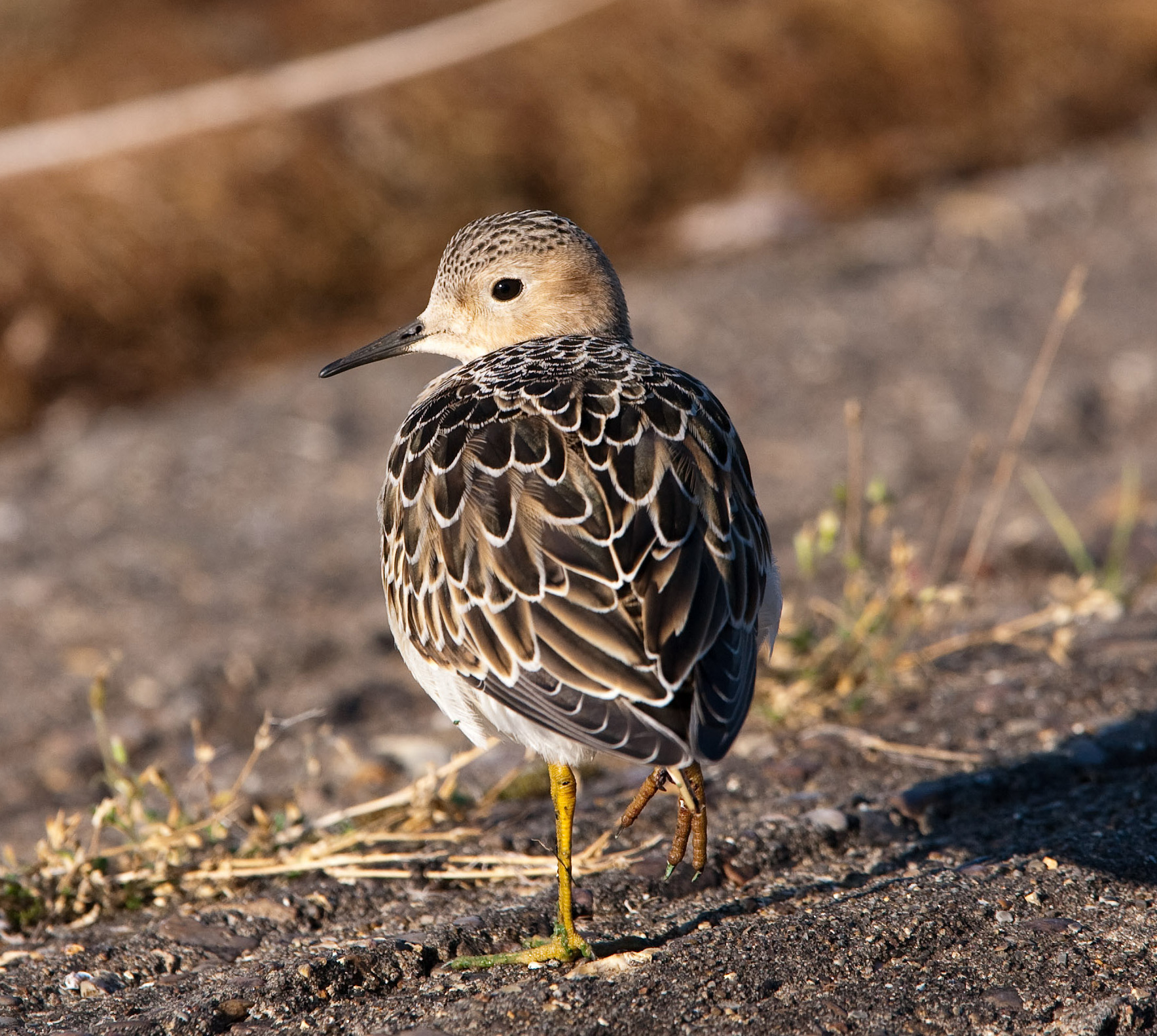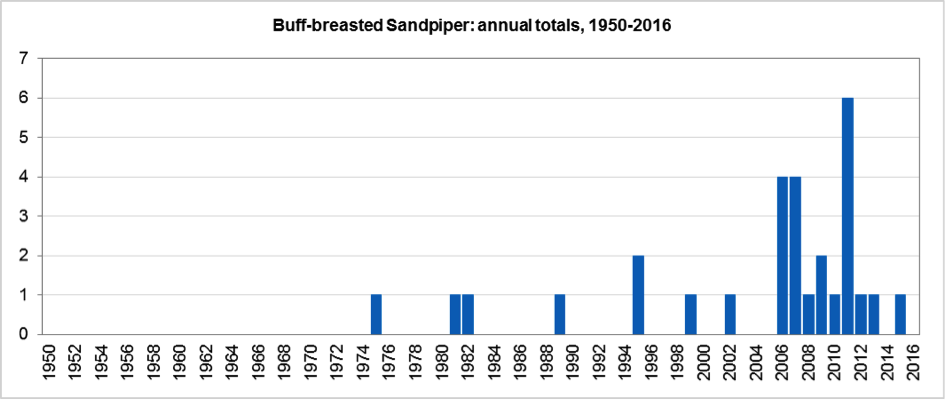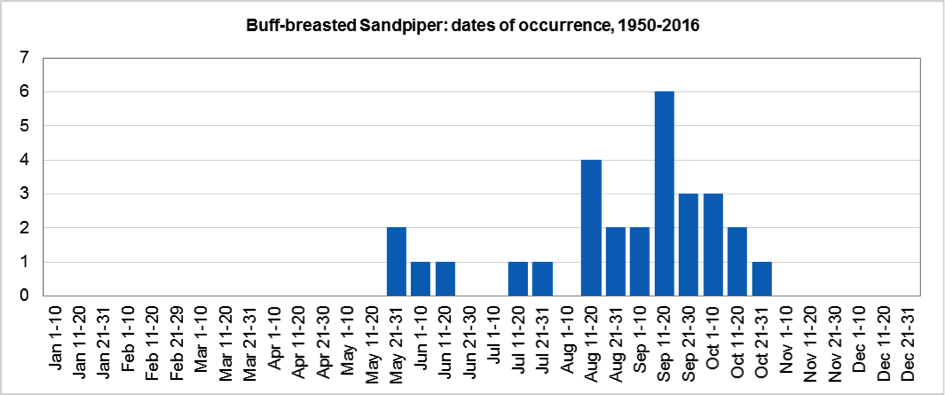Buff-breasted Sandpiper Calidris subruficollis



Buff-breasted Sandpipers (Graham Catley) : Toft Newton Reservoir September 4th 2007; Alkborough Flats May 2009; Saltfleetby-Theddlethorpe NNR September 2011.
One of several species added to the Lincolnshire list by G. H. Caton Haigh was the Buff-breasted Sandpiper, one of which he found and shot on the foreshore at North Cotes on September 20th 1906. The next was not until 1975, but there have now been 30 individuals in the county with the annual average for 1997-2016 being 1.2 birds.
The period 2006-2013 was especially productive, at least one being seen every year and with four in each of 2006 and 2007 and six in 2011 (see first chart). That last year saw the first multiple occurrences, including two adults at Horseshoe Point on August 14th, two juveniles in the Saltfleet Haven-Rimac area during September 19th-22nd (one having been present there or at Donna Nook from the 13th), and two juveniles at Alkborough Flats on October 2nd (possibly the same as those at Saltfleet but counted as different). To put this in context, the last week of September 2011 was notable for the large numbers which arrived in Britain and Ireland when there may have been as many 60, including an incredible flock of 28 at Tacumshin (Wexford) on September 28th.
There have been four spring records (see second chart), all of single birds on single dates, between May 24th and June 12th, the earliest being that at Alkborough Flats on May 24th 2009. A couple of early autumn adults in July are followed by a small gap before the main passage period, with arrival dates spanning August 11th-October 22nd, the latest being one found with Golden Plovers at Kenwick Top, near Louth, on October 22nd 2006. The majority of autumn records have been of juveniles. Most are present for one or just a few days but three have remained for more than a week, the longest being one at Frampton Marsh during September 29th-October 9th 2003 and one first seen over Trent Falls on August 31st 1981 then present on Alkborough Flats during September 3rd-14th 1981.
Almost half of the 33 birds seen up to and including 2019 have been seen along the coast between Cleethorpes and Gibraltar Point. Ten have been in the Humber, including seven at Alkborough Flats alone, and three in The Wash. The remaining three birds were inland, including the one at Kenwick Top mentioned above, one at Covenham Reservoir in October 2006 and one at Toft Newton Reservoir in September 2007.
Buff-breasted Sandpiper ceased to be considered by BBRC in 1983. White and Kehoe (2020) in the report on scarce migrants in Britain gave the total number of British records, 1958-2018 as 1250 with 32 in 2018.


Finder’s report: Buff-breasted Sandpiper, Witham Mouth, September 13th, 1975.
by K. Atkin
Note: account based on the original BBRC submissions; this was the second county record. A minimum of 60 birds were seen in Britain and Ireland in 1975 with first occurrences most obvious on August 28th and September 3rd, 10th-15th and 20th. Northerly records were not significantly later than southerly ones, and a broad front movement across the Atlantic is indicated. The main flight ot the Maritime Provinces of NE America bgan on August 23rd with flocks of up to 18 there in the last 10 days of the month and on September 3rd.
Circumstances
Whilst walking the bank of the River Witham with my brother and his wife I noticed a smallish wader flying towards us from the direction of The Wash. At first it seemed unfamiliar, and it was not until it had drawn level with us and flew within 20 ft. that I realised it was a Buff-breasted Sandpiper. Although I had seen three previously, I realised at the time that I had never seen the species in flight before. The bird continued to fly along the bank of the river only a few feet above the grass towards Boston, but although I searched for a mile or so, I was unable to locate it again. Optics used were 11 x 50 binoculars.
Description
Appearance – a bright, buffish brown wader looking something like a stocky Common Sandpiper in build.
Head – noticeably rounded with a thin, short straight bill, the neck was drawn in. Bright buffish and apart from a dark eye lacked any feature.
Wings – noticeably pointed.
Upperparts – very uniform, bright buffish with dark centres to the mantle feathers and darker primaries lacking any obvious wing bar or tail pattern. Tail looked quite short.
Underparts – breast appeared buffish paling to whitish on the belly. Legs and underwing not seen as the bird was level or below us.
Flight – fairly steady with shallow wing beats like a Common Sandpiper, but without any jerkiness. However, it zig-zagged quite a lot and appeared to want to land on the grassy bank but it was disturbed by other people.
Reference
Rogers, M. J. and the Rarities Committee (1977). Report on rare birds in Great Britain in 1975 (with additions for nine previous years). British Birds 69 (9): 321-368.
(Account prepared October 2017; updated with reference to the new Birds of Lincolnshire (2021) October 2022)

